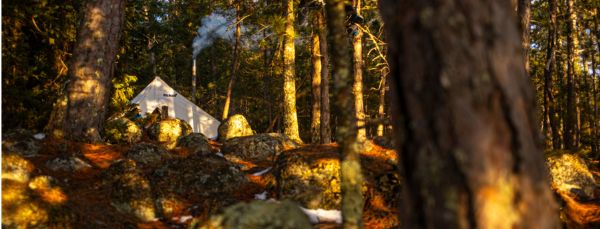Frontcountry and Backcountry Fall Camping with a Hot Tent and Stove
Frontcountry and Backcountry Fall Camping with a Hot Tent and Stove
Autumn in Canada brings a mix of conditions: frost on northern mornings, winds across the prairies, rainy coastal evenings, and uneven terrain in the Shield. Each region presents unique challenges for fall camping in Canada, and a Canadian-made Esker hot tent, paired with an Esker wood stove, makes shoulder season camping warm, comfortable, and accessible.
Frontcountry Fall Camping
Frontcountry camping is a practical introduction to fall and early winter conditions. Drive-in sites and established campgrounds make it easier to set up a hot tent, test a stove, and manage gear without hauling everything deep into the wilderness. It’s a low-risk way to practice stove operation, tent setup, and staying warm during cooler nights.
Note: Cooking inside a hot tent in the fall is not recommended—bears are still foraging, and raccoons, skunks, and other wildlife remain active. Use the stove primarily for warmth or boiling water, and do your cooking outside. If you choose to eat inside the tent after preparing food outdoors, be extremely diligent about crumbs and food debris to avoid attracting wildlife. Always keep your campsite clean.
Different landscapes call for practical adjustments:
- Coastal parks and the Maritimes may benefit from a secondary tarp overhead for added waterproofing.
- Inland forests reward campers who choose elevated, well-drained sites.
- Prairie locations often require natural windbreaks or strategic tent placement to cut down on exposure.
- Choosing areas with trees allows for secure guy lines, which help stabilize the tent in windy conditions.
Frontcountry Essentials (Fall Camping Checklist):
- Larger Canadian-made Esker hot tent for warmth and shelter
- Esker wood stove with dry firewood and fire-starting tools
- Cot with insulated sleeping pad on top for added warmth under your sleeping bag if colder nights are expected
- Extra blankets or sleeping bag liners
- Cookware and ingredients for fall camping breakfasts and dinners
- Cooler for perishables and snacks
- Camp chairs, lanterns, or a small table for comfort
- Waterproof layers for changing weather
- Optional overhead rain tarp if several wet days are forecast
The Esker Multi Tent offers a central ridgeline option, letting you remove the centre pole for a more open, free-flowing interior. A family-size canvas tent quickly becomes a cozy space for meals, conversation, and relaxation. Fall camping meals like oatmeal, pancakes, or hearty stews taste even better when enjoyed inside a warm, glowing shelter while crisp autumn air presses gently outside.
Frontcountry trips give campers the confidence to test gear and stove setups before moving on to the backcountry or full winter conditions.
Backcountry Fall Camping
Backcountry camping offers solitude and immersion in remote landscapes, but it also demands careful planning. Shield lakes can leave the ground damp, northern forests often see early frost, and prairie regions are exposed to wind. Site selection, shelter, and gear all become essential for safety and comfort.
A Canadian-made Esker hot tent and an Esker wood stove are well suited for these conditions. The durable, breathable canvas reduces condensation and withstands fall rain and frost, while the lightweight stove designs make them portable for remote travel without sacrificing warmth. Using nearby trees for guy lines adds stability in open or exposed areas.
Backcountry Essentials (Fall Camping Checklist):
- Compact Canadian-made Esker hot tent for remote trips
- Portable Esker wood stove and fire-starting tools
- Cot with insulated sleeping pad on top if extra warmth is needed
- Extra blankets or liners
- Waterproof clothing and pack cover
- Minimal cookware for simple fall meals (stews, bannock, oatmeal)
- Small axe or saw for processing firewood
- Evergreen boughs for tent floor insulation
- Optional overhead rain tarp if multiple rainy days are expected
Lighting the stove early in the evening helps chase away the chill while you watch leaves fall or a lake reflect the fading sky. Learning how to keep a tent dry in the fall rain, managing ventilation, and following a solid fall camping gear checklist for Canada ensure both comfort and safety. Backcountry trips reward preparation with moments of quiet reflection, wildlife encounters, and opportunities for photography—all enriched by the warmth of a secure hot tent.
Note: As in the frontcountry, avoid cooking inside your tent in the fall. Wildlife remains active—use the stove for heat and boiling water only, and cook outside. If you decide to eat inside the tent afterward, be meticulous about keeping it free of crumbs and spills to avoid attracting curious animals.
Final Thoughts
Fall camping across Canada can be comfortable and memorable with the right preparation. Starting with frontcountry trips builds skills and confidence, while backcountry excursions deepen the experience with solitude and immersion in Canada’s diverse landscapes. Whether you’re looking to buy a hot tent and stove for fall camping, shop Esker tents and Esker stoves for October adventures, or choose Canadian-made canvas tents paired with Esker wood stoves for autumn camping, the right setup makes fall camping in October both cozy and rewarding.








